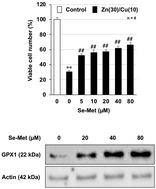当前位置:
X-MOL 学术
›
Metallomics
›
论文详情
Our official English website, www.x-mol.net, welcomes your
feedback! (Note: you will need to create a separate account there.)
Seleno-L-methionine suppresses copper-enhanced zinc-induced neuronal cell death via induction of glutathione peroxidase.
Metallomics ( IF 2.9 ) Pub Date : 2020-09-04 , DOI: 10.1039/d0mt00136h Yukari Nakano 1 , Mikako Shimoda , Saki Okudomi , Sayuri Kawaraya , Masahiro Kawahara , Ken-Ichiro Tanaka
Metallomics ( IF 2.9 ) Pub Date : 2020-09-04 , DOI: 10.1039/d0mt00136h Yukari Nakano 1 , Mikako Shimoda , Saki Okudomi , Sayuri Kawaraya , Masahiro Kawahara , Ken-Ichiro Tanaka
Affiliation

|
Excessive zinc ion (Zn2+) release is induced in pathological situations and causes neuronal cell death. Previously, we have reported that copper ions (Cu2+) markedly exacerbated Zn2+-induced neuronal cell death by potentiating oxidative stress, the endoplasmic reticulum (ER) stress response, and the activation of the c-Jun amino-terminal kinase (JNK) signaling pathway. In contrast, selenium (Se), an essential trace element, and amino acids containing selenium (such as seleno-L-methionine) have been reported to inhibit stress-induced neuronal cell death and oxidative stress. Thus, we investigated the effect of seleno-L-methionine on Cu2+/Zn2+-induced neuronal cell death in GT1–7 cells. Seleno-L-methionine treatment clearly restored the Cu2+/Zn2+-induced decrease in the viable cell number and attenuated the Cu2+/Zn2+-induced cytotoxicity. Accordingly, the levels of ER stress-related factors (especially, CHOP and GADD34) and of phosphorylated JNK increased upon CuCl2 and ZnCl2 co-treatment, whereas pre-treatment with seleno-L-methionine significantly suppressed these upregulations. Analysis of reactive oxygen species (ROS) as upstream factors of these pathways revealed that Cu2+/Zn2+-induced ROS production was clearly suppressed by seleno-L-methionine treatment. Finally, we found that seleno-L-methionine induced the antioxidative protein, glutathione peroxidase. Taken together, our findings suggest that seleno-L-methionine suppresses Cu2+/Zn2+-induced neuronal cell death and oxidative stress via induction of glutathione peroxidase. Thus, we think that seleno-L-methionine may help prevent refractory neurological diseases.
中文翻译:

Seleno-L-甲硫氨酸通过诱导谷胱甘肽过氧化物酶抑制铜增强的锌诱导的神经元细胞死亡。
在病理情况下会诱导过量的锌离子 (Zn 2+ ) 释放并导致神经元细胞死亡。此前,我们曾报道铜离子 (Cu 2+ )通过加强氧化应激、内质网 (ER) 应激反应和 c-Jun 氨基末端激酶的激活,显着加剧了 Zn 2+诱导的神经元细胞死亡。 JNK) 信号通路。相反,据报道,硒(一种必需微量元素)和含有硒的氨基酸(如硒-L-蛋氨酸)可抑制应激诱导的神经元细胞死亡和氧化应激。因此,我们研究了硒-L-蛋氨酸对 Cu 2+ /Zn 2+ 的影响-诱导 GT1-7 细胞中的神经元细胞死亡。Seleno- L-甲硫氨酸处理清楚地恢复了Cu 2+ /Zn 2+诱导的活细胞数量减少并减弱了Cu 2+ /Zn 2+诱导的细胞毒性。因此,内质网应激相关因子(尤其是CHOP 和GADD34)和磷酸化JNK 的水平在CuCl 2和ZnCl 2共同处理后增加,而用硒代-L-甲硫氨酸预处理显着抑制这些上调。对作为这些途径上游因素的活性氧 (ROS) 的分析表明,Cu 2+ /Zn 2+硒-L-甲硫氨酸处理明显抑制了-诱导的ROS产生。最后,我们发现硒-L-甲硫氨酸诱导抗氧化蛋白谷胱甘肽过氧化物酶。总之,我们的研究结果表明硒-L-甲硫氨酸通过诱导谷胱甘肽过氧化物酶抑制Cu 2+ /Zn 2+诱导的神经元细胞死亡和氧化应激。因此,我们认为硒-L-蛋氨酸可能有助于预防难治性神经系统疾病。
更新日期:2020-11-03
中文翻译:

Seleno-L-甲硫氨酸通过诱导谷胱甘肽过氧化物酶抑制铜增强的锌诱导的神经元细胞死亡。
在病理情况下会诱导过量的锌离子 (Zn 2+ ) 释放并导致神经元细胞死亡。此前,我们曾报道铜离子 (Cu 2+ )通过加强氧化应激、内质网 (ER) 应激反应和 c-Jun 氨基末端激酶的激活,显着加剧了 Zn 2+诱导的神经元细胞死亡。 JNK) 信号通路。相反,据报道,硒(一种必需微量元素)和含有硒的氨基酸(如硒-L-蛋氨酸)可抑制应激诱导的神经元细胞死亡和氧化应激。因此,我们研究了硒-L-蛋氨酸对 Cu 2+ /Zn 2+ 的影响-诱导 GT1-7 细胞中的神经元细胞死亡。Seleno- L-甲硫氨酸处理清楚地恢复了Cu 2+ /Zn 2+诱导的活细胞数量减少并减弱了Cu 2+ /Zn 2+诱导的细胞毒性。因此,内质网应激相关因子(尤其是CHOP 和GADD34)和磷酸化JNK 的水平在CuCl 2和ZnCl 2共同处理后增加,而用硒代-L-甲硫氨酸预处理显着抑制这些上调。对作为这些途径上游因素的活性氧 (ROS) 的分析表明,Cu 2+ /Zn 2+硒-L-甲硫氨酸处理明显抑制了-诱导的ROS产生。最后,我们发现硒-L-甲硫氨酸诱导抗氧化蛋白谷胱甘肽过氧化物酶。总之,我们的研究结果表明硒-L-甲硫氨酸通过诱导谷胱甘肽过氧化物酶抑制Cu 2+ /Zn 2+诱导的神经元细胞死亡和氧化应激。因此,我们认为硒-L-蛋氨酸可能有助于预防难治性神经系统疾病。











































 京公网安备 11010802027423号
京公网安备 11010802027423号